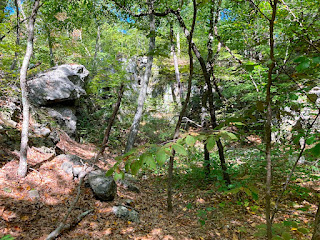I'm not a rock hound but when I discovered there were some ancient quarries nearby from online research I had to check them out!
The Pipeline Trail
Parking where the pipeline crosses Dayton Road, you follow the trail downhill (in the southwesterly direction).
Quarry#1
It looked like there might have been an old carriage line here that leads to the first quarry, just south of the pipeline trail.
 |
| It was hard to get a decent photo with the foliage |
Quarry #2
Further downhill,the next quarry was much bigger and a bit easier to get some photos...
 |
| Lines added to indicate where the rock cut lied |
 |
| slag pile |
 |
| another slag pile |
-short video-
Right before before the big dip that connects you connect to Raymond Drive, the dirt road turns abruptly northward. There are three rock cuts on the east side that were former quarries...
and on the west side is a old rock wall supporting a large embankment
 |
and a bit further north, a slag pile
Shiny rocks (apparently mostly Mica) were visible all along the jeep road in this section. Photo of samples:
Bushwacking Consequences
Once I returned to the car, I had to pick off an endless amount of small brown seeds that stuck to all my clothes!
Further Info
The quarrying in Connecticut of pegmatites for feldspar began around 1825.
The first in the South Glastonbury vicinity I hiked, the Howe quarry, opened in 1866 and produced 200,000 tons of feldspar between 1866 to 1899. Many quarries were operated during World War II for sheet mica and beryl. From 1942 to 1945 Connecticut produced 60,000 pounds of sheet mica and 26 tons of beryl. Of this, 87 percent came from the Middletown area.
Access to the quarry remnants are through a trail system that follows old carriage roads, mine roads and pipeline rights-of-way.
The Quarries and Minerals of the Dayton Road District, South Glastonbury, Connecticut
This site by John H. Betts is what I used for general guidance. There are a lot of historical info almost the names of the name and the dates of operation
The Industrial Might of Connecticut Pegmatite
A wonderful historical summation:
Pegmatite, a granite-like rock made up chiefly of feldspar, quartz, and mica, was formed by magma, or melted rock, that squeezed its way between layers of existing rock. Unlike lava, it remained below ground, never erupting through the surface. Pegmatite can be either simple or complex depending upon the chemical elements in the molten rock of which it is made up of.















No comments:
Post a Comment